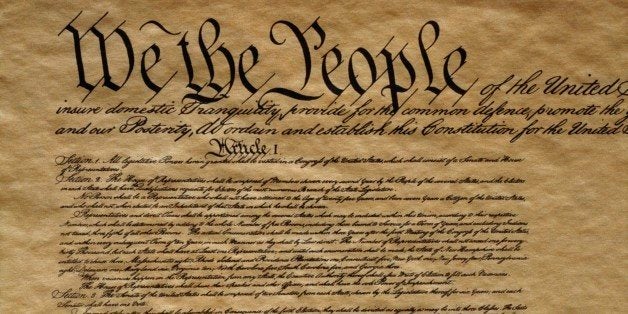
When I assign students in my American Government classes to read the Constitution, a document whose birthday the nation commemorates on September 17, I ask them how many have read the main body of it--really read it, front to back--before. Few raise their hands. They are college freshman and sophomores, mostly, having generally graduated from high schools with civics requirements.
It's enough to prompt grumpy cynicism and a stereotype of professorial handwringing, but it's not quite as simple as a these-kids-today failure of civic education. They are getting civic education, and they are absorbing it. The problem is misdirection. The follow-up question--how many have read the Bill of Rights--invariably elicits the hands of virtually the entire class.
If, as Aristotle says, the nature of civic education reveals the true character of a regime, ours is caught somewhere between a proclivity toward the easy road and a saturation with the phenomenon Mary Ann Glendon calls "rights talk," the substitution of assertions of rights for political conversation.
The easy road is the one with the shorter, simpler reading assignment, which, incidentally, is exactly the one the Father of the Bill of Rights, James Madison, did not want students to be assigned. He wanted the amendments he proposed woven into the text of the Constitution itself, perhaps so there would not be a separate edifice called the Bill of Rights that seemed to trump the main body of the document.
The meaning of the main body of the Constitution, by contrast, is not captured simply in the requirements of a Senator's minimum age or the mechanics of the Electoral College. The beauty lies in the relationships between the parts, the architecture of separation of powers, the suggestive silences and significant specifications. These require more analytical rigor and political imagination to comprehend.
Alexander Hamilton, opposing a Bill of Rights, said the Constitution itself was one. He meant the overall mechanics of the regime's operation were the best guarantor of liberty, and that supplanting them with what Madison derided as the "parchment barriers" of a Bill of Rights might leave the citizen more, not less, exposed.
It is the main body of the Constitution that also most captures our aspirations for measured, deliberate self-government. Of course, the Bill of Rights, too, was meant to season majorities. Madison said one of its main purposes was to slow majorities in their headlong rushes to pass illiberal legislation.
But it has become legal, a tool the courts use to remove issues from the realm of politics. Consequently, the hyper-assertion of rights in isolation from the main body of the Constitution has become hostile to politics itself. Individuals increasingly see themselves as islands isolated from one another and the political community.
Meanwhile, unaware of such issues as the proper extent and distribution of powers, many citizens are unequipped to evaluate questions like the propriety of exercises of presidential or judicial authority, both of which are growing--for good, some say; at the expense of liberty, others reply. Surely a change of such magnitude in the regime ought to be an informed choice, and a self-conscious one. But the Bill of Rights alone does not speak to it.
That's the challenge. But it also reveals the answer. Americans have always been hyper-aware of individual liberties, something Tocqueville noticed on his travels nearly two centuries ago. But civic education's emphasis on the Bill of Rights at the expense of the main body of the Constitution has accentuated it--and, crucially, it has worked.
That suggests that a reorientation of civic education toward teaching the whole Constitution might work too. By all means, an argument for reading the Bill of Rights in terms of individual liberties and for prioritizing them should be heard. But students should be fully informed, and that means reading the entire document--not to mention illumining it with such sources as The Federalist.
Efforts to improve constitutional education are under way. The Jack Miller Center for Teaching America's Founding Principles and History, for example, one of the great endeavors of civic philanthropy in the nation today, sponsors a series of Constitution Day events around the country, among a range of other teaching and research initiatives on the Founding.
To be sure, such efforts to teach the whole Constitution involve challenging students. But the genius of America's framing document is its simplicity. The main body is less than 5,000 words. It is not, like the European Union's constitution, an opus that tries to settle all disputes.
That enduring work is left to citizens. They ought to know more about the tools they inherit with which to perform it. Constitution Day would be an excellent time to start.

